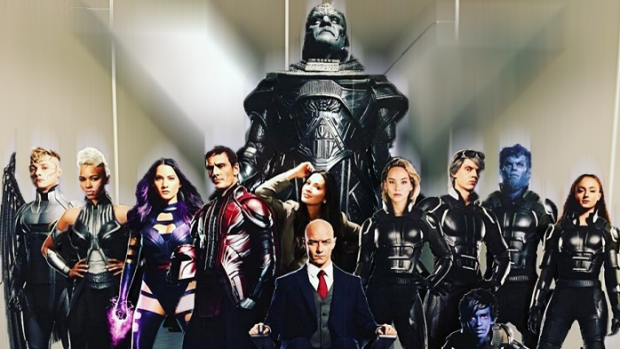Jim Schembri’s new release movies – May 21

X-MEN APOCALYPSE ***1/2 (144 minutes) M
It’s amazing how anybody has managed to survive so long yet, believe it or not, it’s been a whole three weeks since the release of the last mega-budget superhero movie.
And, as it turns out, this one is exceptionally good – and that’s not just a reaction to Batman vs Superman being so exceptionally bad.
We begin in Ancient Egypt where the story of X-Men’s super-powered mutants apparently begins as a beastie named En Sabah Nur (played by Oscar Isaac and who is later nicknamed Apocalypse, presumably for ease-of-pronunciation purposes) rises before he can be buried in the depths of a glistening pyramid.
Via one of those marvellously designed opening credit sequences that could stand alone as a work of art, we jump to 1983 where our mega mutant Apocalypse decides to restart civilisation.
This involves gathering his own posse of four helpers – anyone tracking the film’s biblical references will lose count – and, thus, puts him at odds with those X-Men and X-Women we’ve come to love and accept despite those unfortunate mutations that have rendered them all with super-powers and that special other-worldly sex appeal.
X-Men: Apocalypse is the ninth in the Marvel sub-franchise and the third to be directed by superhero specialist Bryan Singer. He also did X-Men (2000), X2 (2003), X-Men: Days of Future Past (2014) and Superman Returns (2006), so his multiplex movie credentials are sound enough, though he’s never done anything better than the twisty-turny crime thriller The Usual Suspects, which he made way back in 1995.
That said, Singer has managed to pump out what is probably the best X-Men film after First Class. He really does demonstrate what a difference a director can make to a mega-film such as this.
Unlike so many superhero films that push hard on the sound and fury pedals, Singer likes to hold his shots, space his edits and orchestrate his action scenes so that they at least allow for breathing space and make visual sense.
Here, with events taking place some ten years after the previous film, he is also big on giving his main characters a solid dramatic grounding, with Michael Fassbender doing especially good work as the former bad guy who just wants to be left alone with an ordinary life. Lovers of the Godfather films will see parallels between the Magneto in this movie and Michael Corleone in Godfather III.
Nothing so grand is on offer from James McAvoy as Dr Xavier, though he again deploys his most earnest of brows for the role as he again joins the ensemble with Jennifer Lawrence (what does she do with all that franchise money?) and the ubiquitous Rose Byrne.
There’s much more to the spectacle in this film than the usual tornadoes of rubble – though, please note, there are still tornadoes of rubble present – and the high-quality of those VFX-heavy sequences might have a lot to do with the person credited with designing them, John Dykstra.
Those who call themselves Star Wars buffs but don’t recognise the name should hang their heads in shame before hitting Google.
Dykstra was one of the leading geniuses behind the game-changing special effects in Star Wars. He invented the motion-control camera, known as a Dykstraflex, that was used for shooting special effects. This remarkable camera was capable of seven axes of movement, all of which was stored in a computer so the move could be replicated precisely over and over. This allowed for the addition of different elements into a moving special effects shot so that it appeared seamless (at the time, at least).
So along with all the other things to recommend it, X-Men: Apocalypse has the distinction of having among its crew an artist largely responsible for helping create the technology and culture to which the film’s wonderful visuals owe an eternal debt.

A horse is more than a horse in the remarkable documentary Harry and Snowman.
HARRY & SNOWMAN *** (83 minutes) G
The only serious rivals dogs have for the affection of humans are horses, and this loving film by Ron Davis, assembled mostly from archival footage, is a tribute to just how deep and long that love can go.
In 1950s America an aging, unwanted horse was on its way to be turned into glue when it was saved by Dutch-born horse lover Harry deLeyer, who bought him for $80. Naming him Snowman, deLeyer trained him to be a champion showjumper and media sensation. Horse lovers will not be able to contain themselves. Those who don’t care much for horses will still admire the dedication this guy showed to a creature that was deemed worthless, and how the beast let it be known that it was loved.

Strings away: Highly Strung offers an eye-opening look at the classical music world, warts and all.
HIGHLY STRUNG ***1/2 (103 minutes) M
After the acclaim of his masterful 2007 documentary Glass: A Portrait of Philip in Twelve Parts, director Scott Hicks (Shine) again flexes his flair for documentary in this fascinating, surprisingly absorbing documentary about the formation of the new Australian String Quartet and the love of classical intruments.
But what starts out as a straightforward doco morphs into Spinal Tap With Strings when personality differences threaten to break up the band.
In stark contrast to these goings on in Adelaide, Hicks cuts to the Big Apple where he profiles the Carpenters, a hugely successful New York string quartet. They’re wealthy media darlings whose dedication to their art only marginally eclipses their savvy for marketing and branding. The film’s celebration of their chutzpah comes close to parody, but never quite crosses that line.
Those who never thought they would ever care about how violins are made are bound to find the film full of surprises. As for the depth of the relationship musicians can have with their instruments, the film leaves it up to you to decide just how far a person can imbue human qualities and feelings on an old fiddle, even one that is worth millions of dollars.















